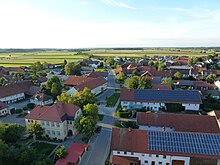Loops
Coordinates: 47 ° 58 ′ 10.9 ″ N , 10 ° 37 ′ 18.5 ″ E
Schlingen is a district of the town of Bad Wörishofen on the eastern border of the Swabian district of Unterallgäu , west of the Wertach . Schlingen is 642 m above sea level. NN and covers an area of around 1337 hectares.
history
Schlingen is the oldest place within the Bad Wörishofen urban area: Schlingen was first mentioned in a document in 897, but the place may have been founded at the end of the 5th century. Burial mounds from the Hallstatt period and row graves of the Alemannic settlers as well as numerous finds from the time of the Cord Ceramics , from the Bronze Age , from the Iron Age and from the time of the Romans indicate that the area was inhabited very early. The Roman road from Augsburg to Bregenz ran through the Schlingen area.
Since the founding of the Irsee Monastery in 1180, donations from Schlingen have flowed there. In 1363 the Irsee monastery received the Maierhof as a Seelgerät and around 1530 it was acquired by the village court of Schlingen. At that time, only a few goods in slings belonged to other rulers. The church set was initially held by the Ronsberg rulers and was then sold to the Kempten and Ottobeuren monasteries . When the monastery was abolished in the course of secularization , the Bavarian state took control of Schlingen.
The hamlet of Frankenhofen has belonged to Schlingen since the municipal edict of 1818 . In 1840 425 inhabitants were registered in Schlingen. On July 1, 1972, the community was incorporated into the city of Bad Wörishofen as part of the state-wide regional reform. The last mayor before incorporation was Anton Satzger (1966–1972). In 2015 Schlingen had 719 inhabitants.
Attractions
See also: List of architectural monuments in Schlingen
The church of St. Martin in Schlingen is one of the oldest churches in the area due to the patronage of St. Martin and the history of settlement in Schlingen. However, the church did not get its present form until 1761-1768 in the Rococo style . The ceiling frescoes of the church are by Franz Anton Zeiller from 1763, the stucco was created by the Wessobrunn master Johann Michael Steinhauser.
literature
- Reinhard H. Seitz (Ed.): Wörishofen on the way to the Kneipp spa, to the bath and the city . Kunstverlag Fink, Lindenberg 2004, ISBN 3-89870-199-9 .
Web links
Individual evidence
- ^ Wilhelm Volkert (ed.): Handbook of Bavarian offices, communities and courts 1799–1980 . CH Beck, Munich 1983, ISBN 3-406-09669-7 , p. 492 .
- ↑ Population statistics for the city of Bad Wörishofen.Retrieved on August 31, 2017
- ↑ Otto Baumgärtner: The message of our churches - churches and chapels in the Kneipp town of Bad Wörishofen , Bad Wörishofen 1996, pp. 30–33.


